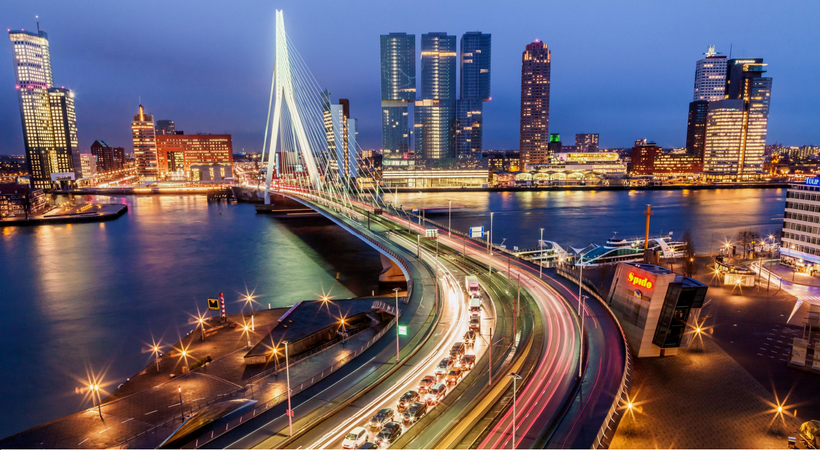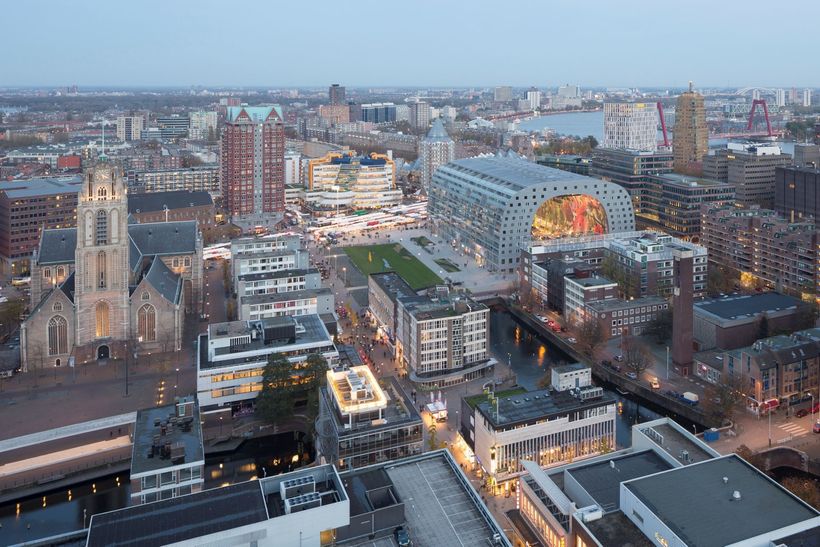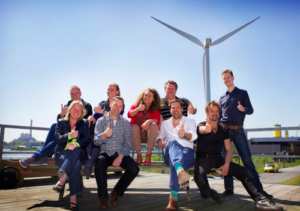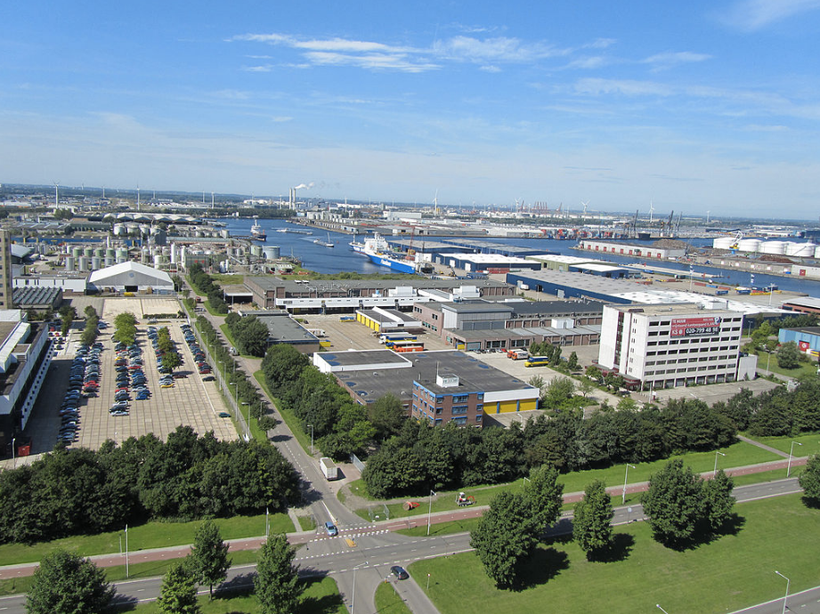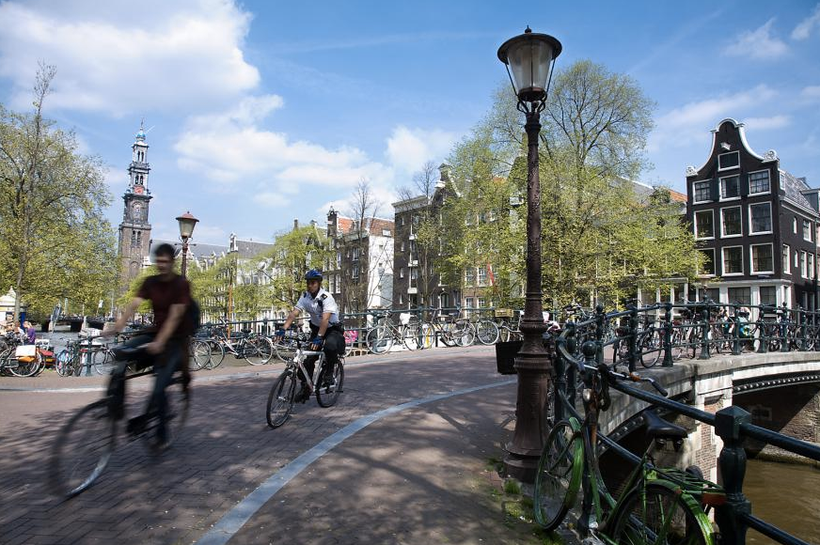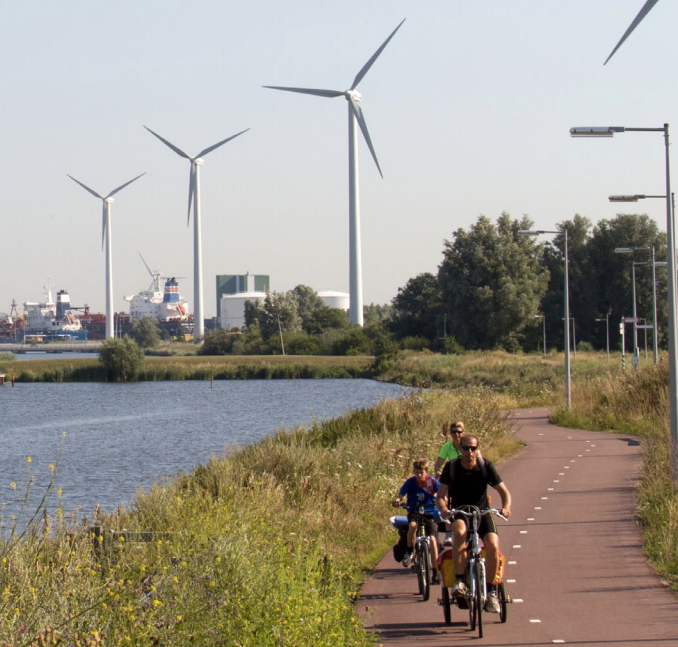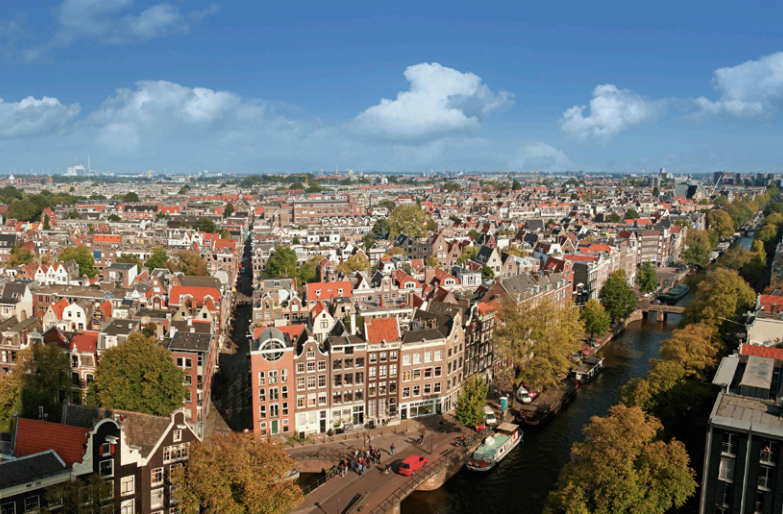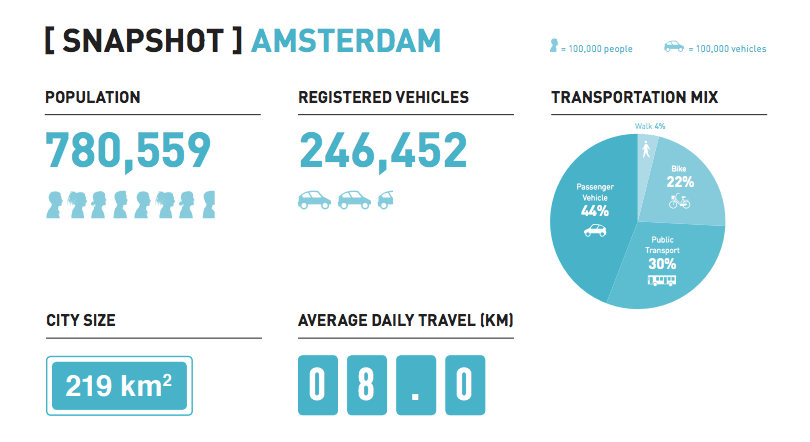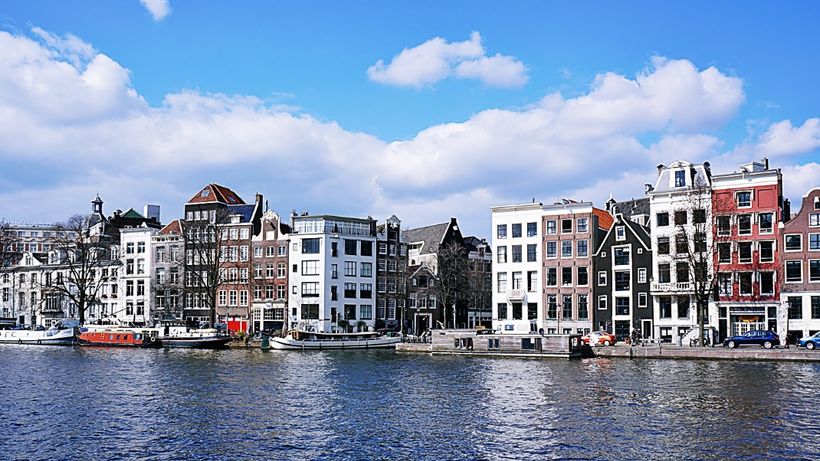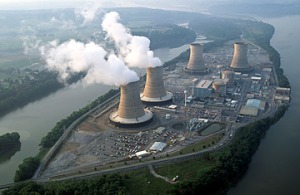First of a series of articles about the Netherlands’ efforts to increase its reliance on renewable energy and energy efficiency. This article tells how the Netherlands took its first major step toward a sustainable energy future beyond fossil fuels, plus the challenges that remain for the nation and the world.
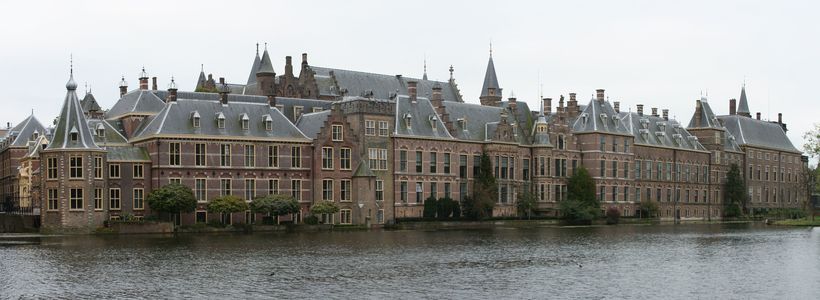
Panoramic view of the Binnenhof, The Hague, where the Dutch Parliament meets. In 2015, a Dutch federal court in The Hague ordered the government to lower its carbon emissions 25 percent below 1990 levels by 2020. Image by JESTERHAT84.
Amsterdam, The Netherlands ― I visited the Netherlands in November of last year as part of a European research trip to learn more about European cities seen as “front runners” in the global effort to reduce their greenhouse gas emissions.
Today, 55 percent of all people on Earth live in cities, and two-thirds of all people or more are expected to be city dwellers in just 34 years, when global population will swell to 9.7 billion, according to the UN Department of Economic and Social Affairs.
Therefore, unless the world’s cities are able to radically reduce their carbon emissions, it will be impossible for the world to keep greenhouse gas emissions from soaring to dangerous new heights.
Leader and Laggard
The Netherlands would like to be regarded as a pace-setter in clean energy but lags most other nations in the European Union. It currently gets only 5.8 percent of its energy from renewable sources, according to the Netherlands Statistical Bureau (CBS).
However, the capital city of Amsterdam has been making important strides toward sustainability and has ambitious climate goals. The city plans to reduce its carbon emissions 40 percent below 1990 levels by 2025 and 75 percent lower by 2040. (Amsterdam’s efforts will be described in subsequent articles in this series.) Whereas the Netherlands, meanwhile, is striving to reduce its reliance on fossil fuels, its climate policy is less ambitious and is marred by controversy.
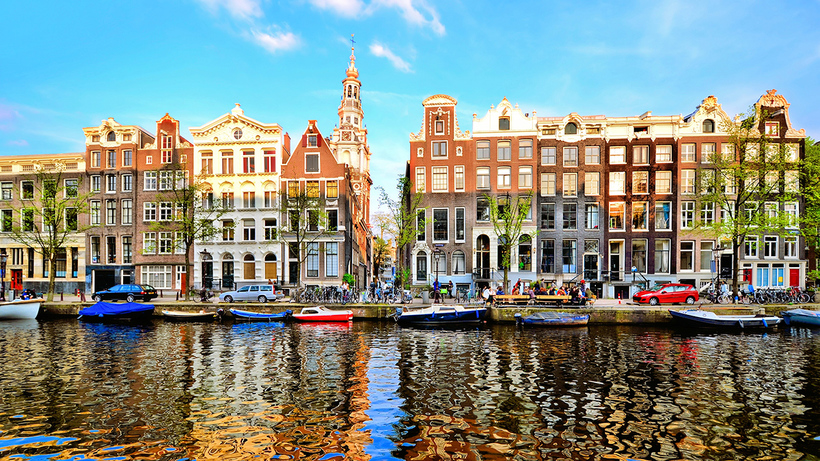
Boats reflected in an Amsterdam canal, The Netherlands. Image by Geoguessr.
Breach of Duty
In response to a federal lawsuit in The Hague initiated in 2013 by Director Marjan Minnesma of the Urgenda Foundation and nearly 900 co-defendants, the Dutch government in June 2015 was put under a court order to reduce its greenhouse gas emissions by 25 percent by 2020, compared with 1990 rates.
The court sided with the plaintiffs’ argument that under Article 21 of the Dutch Constitution and other binding legal documents, including the European Convention on Human Rights, the government’s failure to take more effective action to prevent climate change was breaching its duty to protect its citizens from harm.
Previously, the government’s 2020 goal was an emissions reduction of only 17 percent relative to 1990. It has appealed the decision, but while the case works its way through the appeals process, the government is implementing the ruling.

Eighteenth century windmills, once used to drain Holland’s fenlands (a type of marsh), are now a UNESCO World Heritage Site in the village of Kinderdijk, the Netherlands.
Reducing Reliance on Coal
Partly as a result of the ruling, the Dutch Parliament voted in November 2015 to phase out the use of coal in the Netherlands, although coal still provided about 40 percent of the nation’s electrical power in 2014. .
Three older coal plants have been shut down since 2014, and two more are now scheduled to close in 2017. However, three new ones with even greater capacity were opened in 2013 and 2014. Seven coal plants are currently operating, and it is not yet clear how long the coal phase-out will take.

N.V. Nuon Energy’s 630 MW Hemweg coal power plant in Amsterdam, built in the 1990s, supplies energy to 3.1 million households. Image by Vattenfall.
A Sustainability Accord
Confronted by criticism over its energy policy and the need to change, the government recognized that it needed business, labor, environmentalists and all segments of civil society on board to create a breakthrough energy policy.
On the initiative of a new coalition government comprised of the liberal-conservative Volkspartij voor Vrijheid en Democratie (People’s Party for Freedom and Democracy), and the Partij van de Arbeid (Labour Party), the Netherlands in 2012 adopted an Energy Agreement for Sustainable Growth containing an energy strategy to guide the country in a transition to a wholly sustainable national energy supply by 2050.
The Agreement was drafted by the country’s multi-stakeholder Social and Economic Council (SEC), comprised of politicians, scientists, and other experts from 40 organizations representing business, labor, the environmental sector, and other civil society groups.
The council advises the Dutch government on important social and economic issues with the goal of helping to insure that social prosperity is not construed solely in terms of material wealth and goods, but also in terms of social welfare and social cohesion.
Clean Energy Goals
Milestones set by the agreement include saving 1.5 percent of the country’s final energy consumption per year and increasing the proportion of the energy supplied by renewable energy from a mere 4.4 percent in 2011 to 14 percent in 2020 and 16 percent in 2023.
Activists such as Greenpeace Netherland’s Director Sylvia Borren view the planned 364 percent increase in renewable generation as a major milestone on the path toward a clean energy economy. “Holland [earlier] had done really badly on all aspects of climate change,” she said, unlike Germany and Denmark.
“A few years ago, Greenpeace managed to stop plans for a new nuclear plant,” Borren noted, and the group would like to see all fossil fuel phased out.
Borren was a pivotal participant in the negotiating process that led to the energy accord, and she shared her insights about the process with me in a far-ranging Amsterdam interview.
The Netherlands has got some of the cleaner and more energy-efficient industries in the world, Borren said, and could be a leader in decarbonization.
Carbon Pricing
“The chemical industry has said to me,” Borren reported, “that if the CO2 price in the European carbon trading market were €50-80, then we have so many good plans lying in our cupboards,” to cut our carbon emissions. But currently, she said, “the CO2 price is €8” and industry is not prepared to invest in them for that reason.
Not only is the European emissions trading scheme not working, Borren asserted, but she called it “a perverse scheme,” no more legitimate, for example, than a system for trading child labor rights.
A child labor trading system, she explained, would provide that if you bought a child labor permit in one area, “you [could] trade child labor rights and have a bit more child labor in another.”
Some important energy efficiency measures have already been adopted in the Netherlands. Laws require that all businesses must implement any cost-effective CO2-saving production method that will pay for itself within five years
“That’s a good law,” Borren said, “but it’s not being being implemented and enforced enough.”
Tough Negotiations
That’s when the Council entered the picture to conduct a collaborative and traditional multi-stakeholder Dutch negotiating and decision-making effort based on the country’s venerable “polder model” to help get results. (See “The Polder Model.”)
Realizing that this forum would play an important role in deciding the nation’s energy future, Greenpeace in 2013 abandoned its customary role as an outsider and decided to join in the process.
_______________________________________________________________
The Polder Model
A polder is an area of land reclaimed from the sea by diking. The polder model is a pragmatic, consensus decision-making process that is based on the historic efforts undertaken by Dutch communities from the Middle Ages on to cooperatively build and maintain dikes, both to protect themselves from the sea and to reclaim land for farming and development.
A quarter of the Netherlands lies below sea level. The need for the regular maintenance and repair of dikes and windmills for the pumping of the polders engendered the Dutch habit of cooperation—even across social classes—and a respect for strong governance to manage the polder to prevent disastrous flooding. Cooperation was a matter of life and death.
Today the polder process is internationally known as a way of negotiating a multi-party deal with as little social disturbance, strikes, or top-down government mandates as possible. Labor unions and business groups have used the process to share the impacts of government austerity.
“We have a long history of slow political decision-making through getting all the interested parties in a room and coming to a deal. That’s very much part of our political heritage.” Sylvia Borren explained.
“It is sometimes seen as slow and torturous [but] on the other hand, we do get results with the polder model, because many interested parties have to commit themselves,” she noted.
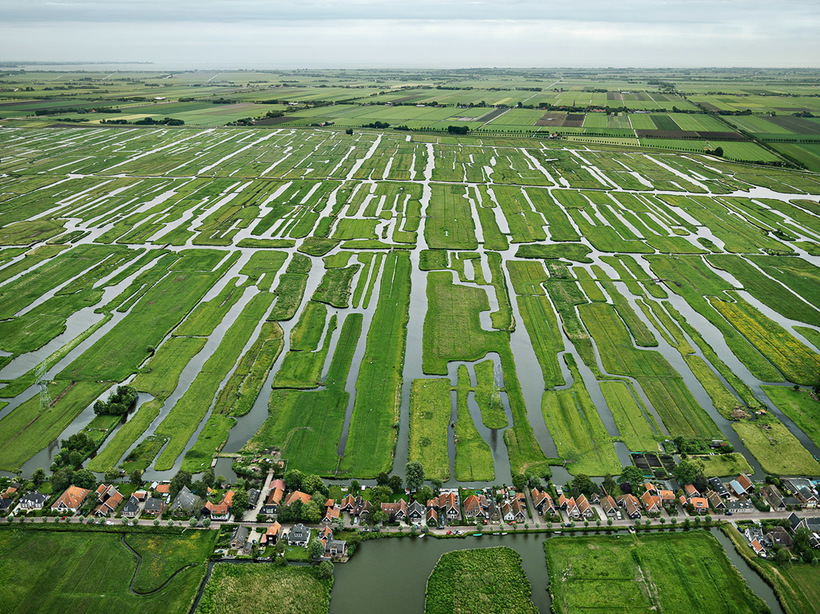
An array of polders and dikes in the countryside of Grootschermer, the Netherlands. Image by Edward Burtynsky.
–––––––––––––––––––––––––––––––––––––––––––––––––––––––––––––––––––––
After months of tough negotiations, the Energy Agreement for Sustainable Growthdeal was signed on September 6, 2013, and Borren saw it as a big breakthrough on renewable energy and energy saving.
The deal provides for increases in wind and solar power production, energy conservation, and some 50 sub-goals, including the closure of old coal plants. “We could easily provide all our energy needs by wind and solar with smart grids to flatten out power peaks and troughs,” Borren asserted.
Towards the end of the negotiating process, Greenpeace conducted demonstrations outside Heineken’s and other large multinational Dutch companies to pressure them to support an ambitious agreement.
“We had other environmental organizations who worked very hard with us on this. We also had a number of green industry leaders who wanted to move faster in the same direction,” Borren said.
“Poldering Coalitions”
There were many coalitions among the 49 parties to the SEC negotiations, including a green business community coalition and a general business community coalition.
“One of the hardest things of even getting to a deal is that we’re working with coalitions,” Borren said. “The business coalition always listen to the more conservative voices in their huge coalition.” Two major trade unions also participated.
“The real breakthrough came when we managed to put pressure on the big members of the business community coalition to move with us and put more pressure on the [government] ministers.” Final negotiations were thus held with government ministers and state secretaries.
Mandatory vs. Voluntary Compliance
Both the liberal-conservative party and the association representing the business community have not wanted compulsory carbon-reduction measures, Borren said. The environmental community in the Netherlands was willing to give voluntary measures a try, but now believes that compulsory measures are needed.
The current policy of just encouraging business to act through good will but without financial incentives or eventual compulsory requirements “will not produce transformation fast enough,” she said. “I do believe that we are moving in the right direction, but far too slow,” she declared.
Implementing the Energy Agreement
The main mechanism for achieving the Netherlands’ projected growth in renewable generation under the Agreement was to be the Sustainable Energy Incentive or SDE, revised as SDE+ in 2011. SDE+ is a subsidy payment from the government to renewable energy producers of power, gas, and heat, paid for by a surcharge on consumers’ energy bills.
Known as a feed-in tariff or premium, SDE+ is designed to ensure that renewable energy production is profitable by covering the difference in the price of renewable energy compared with fossil fuel-based energy for 12- or 15-year periods.
To fulfill the agreement’s wind energy goals, the Agreement calls on the nation to scale up its wind capacity. Offshore wind was to grow from about 1,000 MW in 2010 to 4,450 in 2023. Onshore wind—then about 2,000 MW of capacity—was to be tripled by 2020. This was to be done under regulations set by the Netherlands’ provincial governments. But this process has not always gone smoothly.
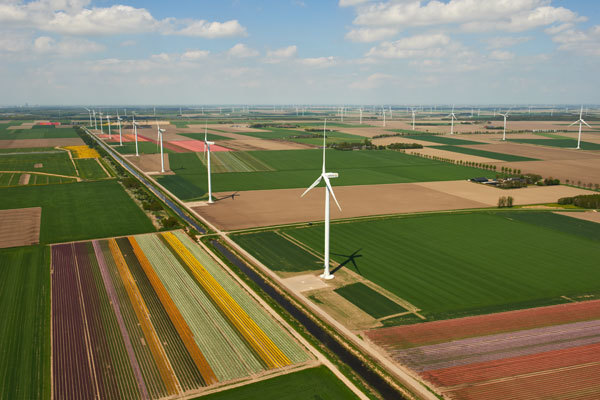
The 122 MW Zuidlob wind farm in the central province of Flevoland, Netherlands, where most of the country’s wind power is produced. Image by Jan Oelker.
(In a forthcoming article, “Wind Energy Challenges in the Netherlands,” [part 5 of the Netherlands series], I will describe some of the problems that people in the Province of North Holland have encountered in expanding the area’s wind capacity in order to move from clean energy planning to reality.)
Lessons Learned
Towards the end of the interview, I asked Borren what she thought the most important lesson was that the world could glean by looking at the process that the Netherlands is going through right now in trying to wean itself from fossil fuels?
“The positive lesson,” she replied, “is that you can get nearly 50 partners around a table and get to a half glass half-full deal. The negative lesson . . . is that when you have a lot of signatures under such a deal, and leadership changes,” then people negotiate backwards after the deal is done.
“[W]e’ve got to have a carrot and a stick in order to keep moving in the right direction. I don’t believe that good will is enough, in terms of the time that we have.” If it was, she added, “we would have had a successful climate deal 25 years ago.”
Borren spends her weekends in a small conservative farming village of 3,000 people outside of Amsterdam. Young people have been leaving, and the community is aging. Borren is encouraged, however, that the village has “re-engaged” some people and now seems to be moving toward a renewable energy economy. “They’re actually revitalizing both the local economy and their social life in a way that’s quite astonishing,” she said enthusiastically.
In the next article of this series, “Sustainable Amsterdam, Part 1—An Ambitious Green Agenda,” I will describe the city’s plans for reducing its greenhouse gas emissions.
*This article was published at The Huffington Post on July 27, 2016
